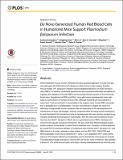| dc.contributor.author | Amaladoss, Anburaj | |
| dc.contributor.author | Chen, Qingfeng | |
| dc.contributor.author | Liu, Min | |
| dc.contributor.author | Dummler, Sara K. | |
| dc.contributor.author | Dao, Ming | |
| dc.contributor.author | Suresh, Subra | |
| dc.contributor.author | Chen, Jianzhu | |
| dc.contributor.author | Preiser, Peter R. | |
| dc.date.accessioned | 2015-08-20T17:14:53Z | |
| dc.date.available | 2015-08-20T17:14:53Z | |
| dc.date.issued | 2015-06 | |
| dc.date.submitted | 2014-05 | |
| dc.identifier.issn | 1932-6203 | |
| dc.identifier.uri | http://hdl.handle.net/1721.1/98123 | |
| dc.description.abstract | Immunodeficient mouse–human chimeras provide a powerful approach to study host specific pathogens like Plasmodium (P.) falciparum that causes human malaria. Existing mouse models of P. falciparum infection require repeated injections of human red blood cells (RBCs). In addition, clodronate lipsomes and anti-neutrophil antibodies are injected to suppress the clearance of human RBCs by the residual immune system of the immunodeficient mice. Engraftment of NOD-scid Il2rg[superscript -/-] mice with human hematopoietic stem cells leads to reconstitution of human immune cells. Although human B cell reconstitution is robust and T cell reconstitution is reasonable in the recipient mice, human RBC reconstitution is generally poor or undetectable. The poor reconstitution is mainly the result of a deficiency of appropriate human cytokines that are necessary for the development and maintenance of these cell lineages. Delivery of plasmid DNA encoding human erythropoietin and interleukin-3 into humanized mice by hydrodynamic tail-vein injection resulted in significantly enhanced reconstitution of erythrocytes. With this improved humanized mouse, here we show that P. falciparum infects de novo generated human RBCs, develops into schizonts and causes successive reinvasion. We also show that different parasite strains exhibit variation in their ability to infect these humanized mice. Parasites could be detected by nested PCR in the blood samples of humanized mice infected with P. falciparum K1 and HB3 strains for 3 cycles, whereas in other strains such as 3D7, DD2, 7G8, FCR3 and W2mef parasites could only be detected for 1 cycle. In vivo adaptation of K1 strain further improves the infection efficiency and parasites can be detected by microscopy for 3 cycles. The parasitemia ranges between 0.13 and 0.25% at the first cycle of infection, falls between 0.08 and 0.15% at the second cycle, and drops to barely detectable levels at the third cycle of infection. Compared to existing mouse models, our model generates human RBCs de novo and does not require the treatment of mice with immunomodulators. | en_US |
| dc.description.sponsorship | Singapore. National Research Foundation (Singapore-MIT Alliance for Research and Technology) | en_US |
| dc.language.iso | en_US | |
| dc.publisher | Public Library of Science | en_US |
| dc.relation.isversionof | http://dx.doi.org/10.1371/journal.pone.0129825 | en_US |
| dc.rights | Creative Commons Attribution | en_US |
| dc.rights.uri | http://creativecommons.org/licenses/by/4.0/ | en_US |
| dc.source | Public Library of Science | en_US |
| dc.title | De Novo Generated Human Red Blood Cells in Humanized Mice Support Plasmodium falciparum Infection | en_US |
| dc.type | Article | en_US |
| dc.identifier.citation | Amaladoss, Anburaj, Qingfeng Chen, Min Liu, Sara K. Dummler, Ming Dao, Subra Suresh, Jianzhu Chen, and Peter R. Preiser. “De Novo Generated Human Red Blood Cells in Humanized Mice Support Plasmodium Falciparum Infection.” Edited by Claudio Romero Farias Marinho. PLoS ONE 10, no. 6 (June 22, 2015): e0129825. | en_US |
| dc.contributor.department | Massachusetts Institute of Technology. Department of Biology | en_US |
| dc.contributor.department | Massachusetts Institute of Technology. Department of Materials Science and Engineering | en_US |
| dc.contributor.department | Koch Institute for Integrative Cancer Research at MIT | en_US |
| dc.contributor.mitauthor | Dao, Ming | en_US |
| dc.contributor.mitauthor | Chen, Jianzhu | en_US |
| dc.relation.journal | PLOS ONE | en_US |
| dc.eprint.version | Final published version | en_US |
| dc.type.uri | http://purl.org/eprint/type/JournalArticle | en_US |
| eprint.status | http://purl.org/eprint/status/PeerReviewed | en_US |
| dspace.orderedauthors | Amaladoss, Anburaj; Chen, Qingfeng; Liu, Min; Dummler, Sara K.; Dao, Ming; Suresh, Subra; Chen, Jianzhu; Preiser, Peter R. | en_US |
| dc.identifier.orcid | https://orcid.org/0000-0002-5687-6154 | |
| mit.license | PUBLISHER_CC | en_US |
| mit.metadata.status | Complete | |
